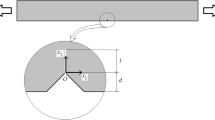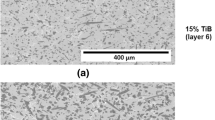Abstract
The fracture toughness of a canasite glass-ceramic with a highly acicular, interlocked grain structure was measured by a number of different methods. The values at room temperature obtained by the chevron-notch, short-bar and notched-beam methods ranged from 4 to 5 M Pa m−1/2, well above literature values for other glass-ceramics. Similar values of toughness were obtained by the fracture of bars with indentation cracks introduced with loads ranging from 1.96 to 400 N, but only for crack sizes >200 μm, with lower values for cracks of smaller size. The toughness values obtained by the direct measurement of the size of the indentation cracks were appreciably lower than the values obtained by all other methods over the total range of indentation loads and corresponding crack size. SEM fractography showed that the surface within the indentation cracks was appreciably smoother than the surrounding fracture surface. The high values of fracture toughness were attributed to the combined mechanisms of crack-deflection and microcrack-toughening due to the stress-enhanced creation of microcracks caused by the residual stresses which arise from the thermal expansion anisotropy of the canasite monoclonic crystal structure. The strong negative temperature dependence of the fracture toughness suggests that at room temperature microcrack toughening represents the primary contributing mechanism to the fracture toughness. The combined effects of crack-deflection and microcrack-toughening can lead to the development of glass-ceramics with greatly improved resistance to crack propagation.
Similar content being viewed by others
References
D. P. H. Hasselman,J. Amer. Ceram. Soc. 52 (1969) 600.
A. G. Evans andA. Heuer,ibid. 63 (1980) 241.
R. M. McMeeking andA. G. Evans,ibid. 65 (1982) 242.
Y. Fu andA. G. Evans,Acta Metall. 30 (1982) 1619.
A. G. Evans andK. T. Faber,J. Amer. Ceram. Soc. 67 (1984) 255.
K. T. Faber andA. G. Evans,Acta Metall. 31 (1983) 565.
A. G. Evans, A. H. Heuer andD. L. Porter, Proceedings of the Fourth International Conference on Fracture, edited by D. M. R. Taplin (University of Waterloo Press, 1977) Vol. 1, p. 529.
F. F. Lange,J. Amer. Ceram. Soc. 56 (1973) 518.
K. T. Faber andA. G. Evans,Acta Metall. 31 (1983) 577.
R. Morena, K. Niihara andD. P. H. Hasselman,J. Amer. Ceram. Soc. 66 (1983) 673.
A. G. Evans andE. A. Charles,ibid,59 (1976) 371.
K. Niihara, R. Morena andD. P. H. Hasselman,J. Mater. Sci. Lett. 1 (1982) 13.
P. Chantikul, G. R. Anstis, B. R. Lawn andD. B. Marshall,J. Amer. Ceram. Soc. 64 (1981) 539.
W. F. Brown Jr andJ. E. Srawley, ASTM Special Technical Publication 410 (American Society for Testing and Materials, Philadelphia, Pennsylvania, 1966) 13.
D. G. Munz, J. L. Shannon andR. T. Bubsey,Int. J. Fracture 16 (1980) R137.
D. G. Munz, R. T. Bubsey andJ. E. Srawley,ibid. 16 (1980) 359.
J. C. Swearengen andR. J. Eagan,J. Mater. Sci. 11 (1976) 1857.
B. G. Koepke, K. D. McHenry andW. D. Savage,Bull. Amer. Ceram. Soc. 58 (1979) 1100.
R. C. Brandt, D. P. H. Hasselman andF. F. Lange, (eds), “Fracture mechanics of Ceramics”, Vols. 1 and 2 (Plenum Press, New York, 1974).
Idem (Plenum, New York, 1978).
Idem (Plenum, New York, 1983).
B. R. Lawn, in “Fracture Mechanics of Ceramics”, Vol. 5, edited by R. C. Bradt, A. G. Evans, D. P. H. Hasselman and F. F. Lange (Plenum Press, New York, 1983) p. 1.
S. Baskaran, S. B. Bhaduri andD. P. H. Hasselman,J. Amer. Ceram. Soc. 68 (1985) 112.
B. R. Lawn andE. R. Fuller,J. Mater. Sci. 10 (1975) 2016.
Author information
Authors and Affiliations
Rights and permissions
About this article
Cite this article
Beall, G.H., Chyung, K., Stewart, R.L. et al. Effect of test method and crack size on the fracture toughness of a chain-silicate glass-ceramic. J Mater Sci 21, 2365–2372 (1986). https://doi.org/10.1007/BF01114280
Received:
Accepted:
Issue Date:
DOI: https://doi.org/10.1007/BF01114280




